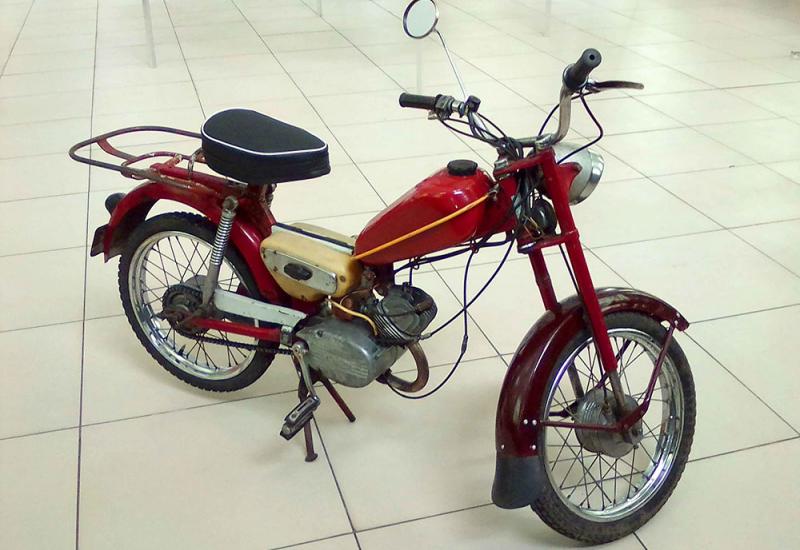At the end of last year to the State Polytechnic Museum at Igor Sikorsky Kyiv Polytechnic Institute an exhibit of equal interest to both teenagers and men, the “Verkhovyna-3” moped, was handed over for temporary display.
Today, almost no one thinks about the term "moped", and it has a very interesting origin. It seems that the moped is the same motorcycle, only smaller, with a weaker engine. This is close enough to the truth, but still not. The term "moped" originated from a combination of two words: "moto" and "pedal". It is essentially a light motorcycle with a pedal drive. Hence the outdated, now ridiculous word "motoped", which in fact also has a right to exist. Today, such vehicles, only with the start of the engine with a foot lever (kickstarter) are also called mopeds. However, since the 50s of the twentieth century. such means are called mokick ("moto", "kickstarter"). Such a seemingly small difference in design, however, is extremely important. On mopeds, the engine was slightly less powerful, and therefore needed pedal assistance when moving up. At the same time, a weak engine could be started with the pedals, ie alternately with the right and left feet. It was difficult to pedal a more powerful engine with a greater degree of compression.
The Lviv Bicycle Plant, where this vehicle was manufactured, was established in the late 1940s. Then the enterprise, which was previously engaged in the production of carts and agricultural implements, received machines from the Kharkiv Bicycle Plant and equipment for the production of bicycles from Germany (for reparations). The main products of the company were bicycles. Since 1958, the company has established the production of motorcycles, which from model to model approached the design of light motorcycles.
In 1970, the MV-048 "Verkhovyna-3" moped was put into serial production, which was the third model with a two-speed engine and the first in the "Verkhovyna" series. The moped was radically different from previous models. Its features: spinal frame of rectangular pipe; capacious tank for 5 litres; wheels 65х405 mm are interchangeable; front wheel suspension with spring telescopic pre-compressed shock absorbers; headlight in the extended case with the indicator of speed and run with the drive from a forward wheel; low steering wheel with rear view mirror; drum-type brakes; the drive of a forward brake with the right lever on a wheel, back - from pedals; suspension of a back wheel pendulum on spring shock-absorbers; seat with faux leather cover and small trunk. The engine of the moped Sh-51K was a Soviet copy of the Czech engine "Java-525": single-cylinder, two-stroke, petrol, with a volume of 49.8 cm3 and a capacity of 2 hp (for comparison, the first motorcycle of the Kyiv plant K-1B "Kievlyanin", produced in 1946-1955, had a capacity of 2.3 hp). The gearbox is two-speed. Switching the clutch release lever with a shifter. Top speed up to 50 km / h, fuel consumption 2 l / 100 km. Weight of the moped - 51 kg. All mopeds of the series were painted in dark red, "cherry" colour.
Before being introduced into production, the moped successfully passed factory tests. Moreover, in the spring of 1970, six serial mopeds "Verkhovyna-3" ran from Lviv to Ulyanovsk. The cars travelled 5,310 km "without any breakdowns.”
Most of 70s teens dreamed of the Verkhovyna-3 moped. Not having the right to ride motorcycles under the age of 16, they looked enviously at the older boys, but could master mopeds. However, at first the moped needed to be registered within the State Automobile Inspectorate, which is why a license plate was installed on the museum's exhibit. Legislation was later amended, and vehicles with an engine capacity of up to 50 cm3 no longer required registration. Simple, cheap, easy, serviceable - it was in demand in the city and in the countryside.
In operation, in addition to the replacement of parts, certain modernizations of the moped often took place. Most often, they consisted of installing footrests for the passenger, sometimes increasing the trunk. The museum exhibit has such design changes. However, it has a fairly high degree of authenticity. Our moped belongs to the first series - it was made in 1971. The gauge of the outdated sample (as on the first models), swamp shields without additional painting with yellow stripes and LMZ stickers on the front shield are installed. Interestingly, the banned in the USSR combination of blue and yellow was used on mopeds until the mid-70's. Only later was the color scheme changed. However, this moped also has non-authentic components - this is the Sh-57 engine from the next model "Verkhovyna-4".
We hope that the moped "Verkhovyna-3" will bring to the visitor not only the spirit of the time, but also the dreams and desires of teenagers of the 70s. He will also tell about the experience of engineers and designers of those times and contribute to a better understanding of the history of science and technology.

